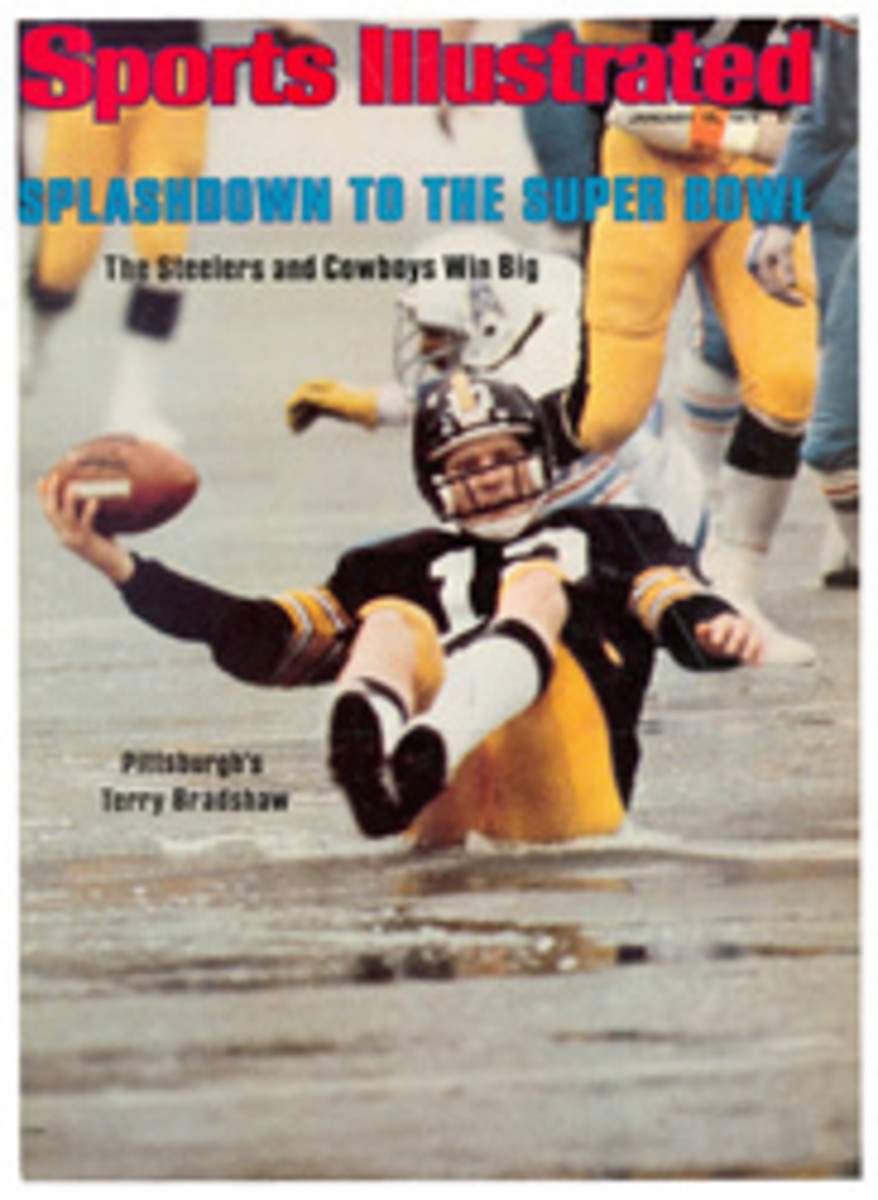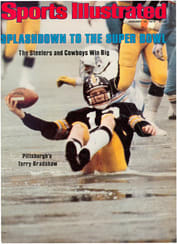
Getting off to a fast start
An indoor track meet is equal parts organized spectacle and pure pandemonium and the Muhammad Ali Invitational in Long Beach, Calif., the first major meet of the season, was no exception. It was a classic, not only for chaos but for remarkable performances. Herman Frazier said after he had set a world record of 1:01.2 in the 500-meter run, "It exploded like a bomb." There were relays for little girls, sprints for old men, and a celebrity 800-meter relay that included high jumper Dwight Stones (whose suspension by the AAU is being appealed), U.S. Senator Alan Cranston, former WBA heavyweight champion Jimmy Ellis and WBC welterweight champ Carlos Palomino and jockeys Angel Cordero and Darrel McHargue.
Ron Clarke's son Marcus came from Australia to run in the high school 1,500, barefoot, and Fortune Gordien's son Marcus was second in the shotput with a heave of 62'1½". Forty-four-year-old Miki Gorman, the tiny queen of the marathoners, won the women's masters 1,500 for the second time, in 4:49.4, and 61-year-old Payton Jordan, the track coach at Stanford for more than two decades, won the 60-meter dash for men 55 and over, also for the second time, in 7.75.
There was something for everyone, including track fans. The 60-meter dash, with a field led by Houston McTear, was so deep in talent it looked like the Olympic Trials. McTear set five indoor world records last season, including a 6.54 in the 60 at the Ali meet. But picking favorites at this time of year is guesswork. McTear's competition was Clancy Edwards, the muscular USC sprinter who last year won the 100 and the 200 at both the NCAA and the AAU meets, a double-double, Steve Riddick, Don Merrick, Harvey Glance, Steve Williams and last year's high school sensation indoors, LaNoris Marshall. McTear won his heat with ease, but he was left in the blocks in the final, and the order of finish was Glance (6.62), Riddick and Williams.
The field for the 60-meter hurdles was just as good—Renaldo Nehemiah, Charles Foster, Greg Foster, Dedy Cooper and Kerry Bethel. Nehemiah set the world indoor mark for 60 yards (7.07) at last winter's Millrose Games, but he had two demoralizing losses to Greg Foster outdoors, which he says, "taught me a lot." In Long Beach the thoughtful Maryland sophomore applied his new knowledge and edged Cooper and Greg Foster to finish in 7.5—hand-timed because the automatic timer broke down.
Nothing in the entire evening, not even Ali himself parading the length of the straightaway with his wife Veronica by his side, could diminish the significance of John Walker's 1,500. The race was the Olympic champion's first on a track in a year. Late last winter the 27-year-old New Zealander flew back home following a lackluster U.S. indoor season and underwent two operations to relieve pressure caused by his calf muscles swelling and restricting the flow of blood in his arteries. The operations were ineffective, but in November Walker resumed training anyway. He had to limit his workouts to 30-minute sessions, which were all his legs could take before the swelling and pain would set in. He ran either five miles on the flat or six on hills in the mornings, and he trained on a track in the afternoons, doing 60-second quarters, one on top of another. Sometimes he would run a 4:03 mile and then try to hold his closing pace for an extra two laps. "Every time I work," he said, "I make sure I work hard."
He was happy with his progress by the time he and his new wife, Helen, came to the U.S. a month ago for the Superstars competition, but he needed a confidence builder, a race with which to gauge his progress. Once in Los Angeles he moved to an apartment in Marina del Rey and worked out alone every day at UCLA. For a break in the routine he ran a five-mile road race and finished 10th in 23:04.
Besides Walker, the 1,500 featured Dick Buerkle, who himself is coming back from the leg injury he suffered after setting the indoor world record of 3:54.9 in the mile last season; Paul Cummings, who finished second to Wilson Waigwa at this meet a year ago, and Marty Liquori. The field was rounded out by Syd Maree, a black South African who attends Villanova, and Ray Flynn, an Irishman who runs for the Mason-Dixon AC.
At the gun Buerkle jumped into the lead, as expected. Maree fell in behind him, and Walker settled into third, about five yards behind the pair. Cummings was last. The field stayed that way through a fast (57.2) 400 and a slower (1:59.3) 800, but suddenly, with three laps of the big 200-meter track left to go, Cummings streaked to the front. Cummings passed 1,200 meters in 2:56.9 with Walker right behind him. Going into the last lap Walker pulled up to Cummings' shoulder and hung there; coming out of the final turn he drew into the lead. "Keeping by his side made him work twice as hard," Walker said later. "If I'd gone ahead he'd have had a rest."
The stratagem worked perfectly and Walker not only had his confidence builder to take back home with him, but he also had the world indoor record—3:37.4—to go with his world outdoor in the mile. Cummings was second in 3:37.6, and Maree, who finished third in 3:38.2, recorded the fourth-best 1,500 ever run indoors. Walker's time replaced the 3:37.8 set in 1971 by Harald Norpoth of West Germany. Thus the Muhammad Ali Invitational, which was only a glimmer in the eye of promoter Harold J. Smith three years ago, had opened the season for the second year in a row with a world record.
Smith is a black 35-year-old entertainment promoter from New York who moved to the West Coast a few years ago and has been making things happen ever since, to the occasional discomfort of Los Angeles' established sports promoters. Smith's involvement in sports began in 1976, when he read a wire-service story that described the desperate financial circumstances of Houston McTear's family. Smith contacted McTear and offered to sponsor him. Two years ago he moved McTear to Southern California to live, go to school and train. Now McTear is married, has a nine-week-old son named Isaac Houston McTear, lives in an apartment in Westwood, trains under the guidance of Hilton Nicholson, a former sprinter from Trinidad and the University of Michigan, and says he is very happy.
Smith was also the man who showed Ali the photograph of the McTear house in Milligan, Fla. that caused Ali to write a check for $30,000 on the spot and tell Smith, "Go buy that family a house." A little later Smith arranged for McTear to meet Ali, and out of the meeting grew the first Muhammad Ali track meet. As Lee Smith, Harold's wife, tells it, Ali wanted to know whether McTear was the fastest runner in the world. When he learned that the matter was open to debate, that sometimes McTear won, but other times Glance, Williams, Riddick, Don Quarrie or someone else won, Ali suggested that they get everybody together to see who was really the best. Smith said done.
When the AAU said it would not sanction a single-event meet, Smith organized a full-fledged outdoor meet at the Cerritos College track on Memorial Day 1977, in which the 100-meter dash was the centerpiece. He claimed in his advertising that Ali would be there, and Ali was there, to the enormous surprise of everyone except the 8,000 fans who showed up to see him. But the meet was not particularly memorable and many of the other athletes Smith had said would be on hand failed to appear. In fact, the meet still has a credibility problem. Five minutes before the 3,000 meters was scheduled to start last Saturday night, a meet official was asked if world-record holder Henry Rono would be running as advertised. The official replied that he would. But Rono didn't. In fact, officials at Washington State, where he is a junior, assumed he was still home in Kenya on semester break.
Now, thanks to a three-year television contract with NBC for five boxing shows and two track meets a year, Smith has the money to organize his meet, even if he is spending it in rather unorthodox ways. Customarily, indoor-meet promoters invest heavily in imported stars for a few glamorous events. They then flesh out the program with lesser lights from local colleges and clubs. Smith boasted last week that 75% of the athletes in his meet were from outside California. But he was proudest of his college 1,600-meter relay named for Dr. Martin Luther King Jr., for which he brought together teams from five predominantly black colleges—Grambling, Southern, Florida A&M, Howard and Texas Southern. "They don't get an opportunity very often to run in California or on TV," Smith said of his investment, which was appreciated most by the Southern squad that won the event by 20 meters in 3:11.4.
Al Franken, who has run the Sunkist Invitational (formerly the Los Angeles Invitational) since the early '60s, estimates that Smith spent $10,000 to indulge this particular whim. Ron Stanko, an athletic shoe company representative, said, "If Smith had the expertise and all that NBC money, he could fly in Steve Ovett from England and fill the stadium for the mile. But he spends on obscure events."
To which Smith says, "This is what Harold Smith is all about. I want to do something that will bring us all together and that we can be proud of. I've spent a lot of money. Now the other promoters have to spend money. This is a hard act to follow."
PHOTO
John Walker made a comeback, coming from behind Cummings to win the 1,500 in a record 3:37.4.

